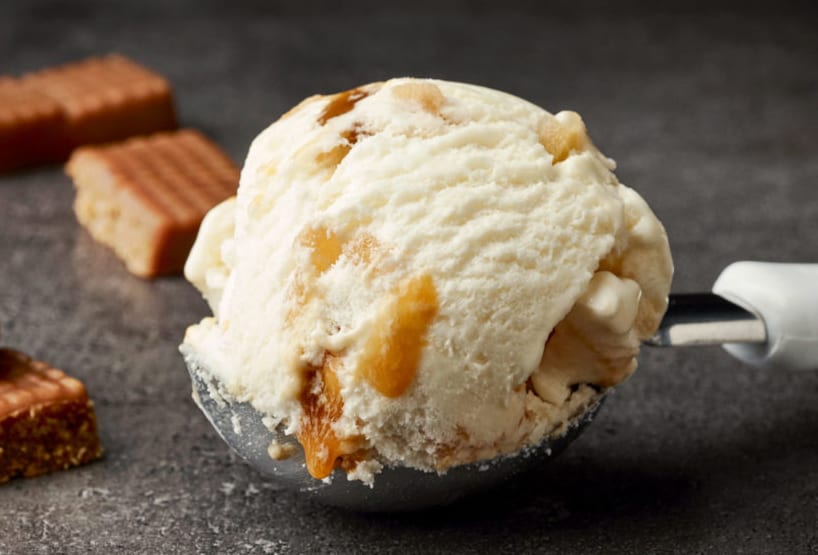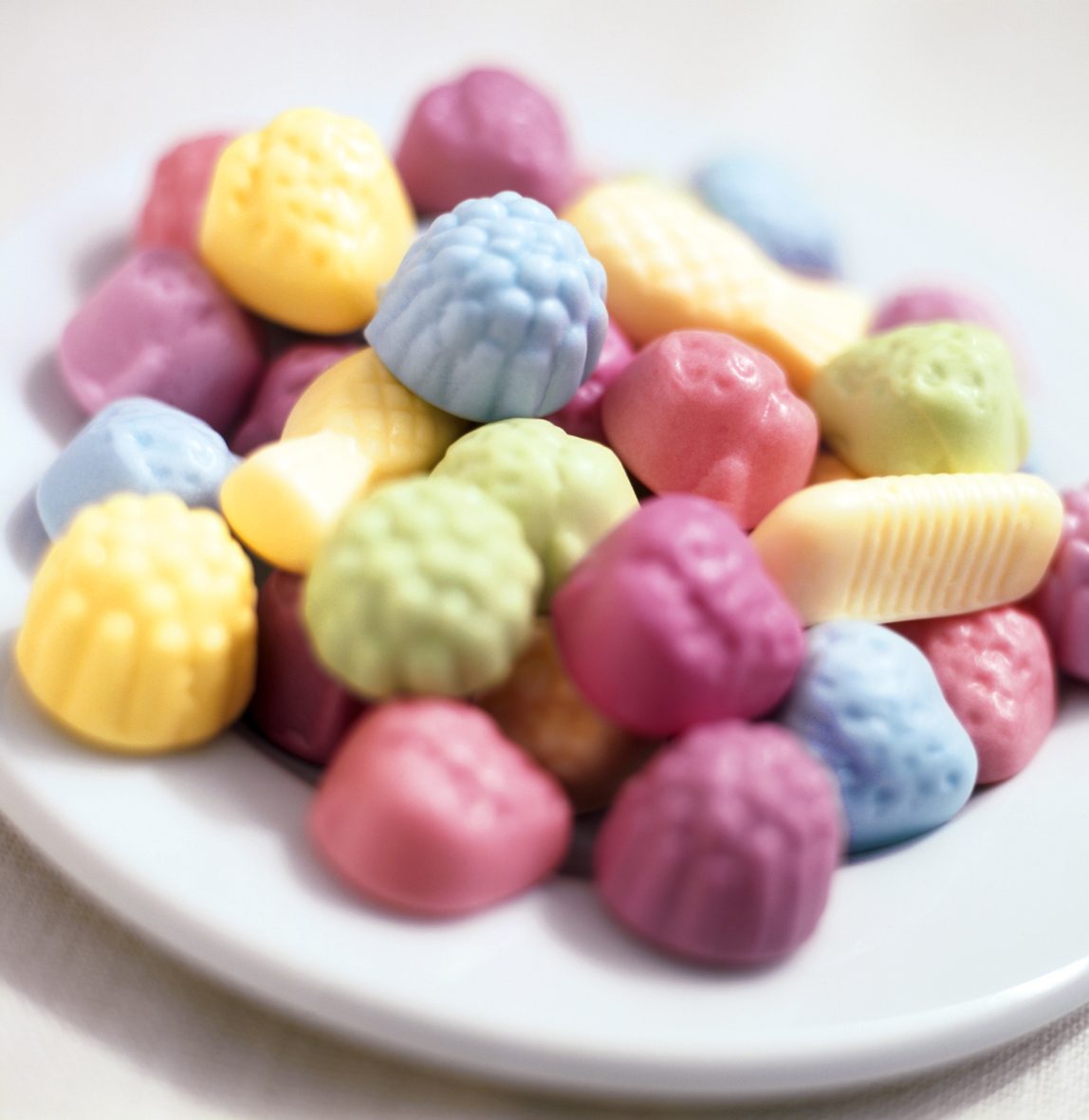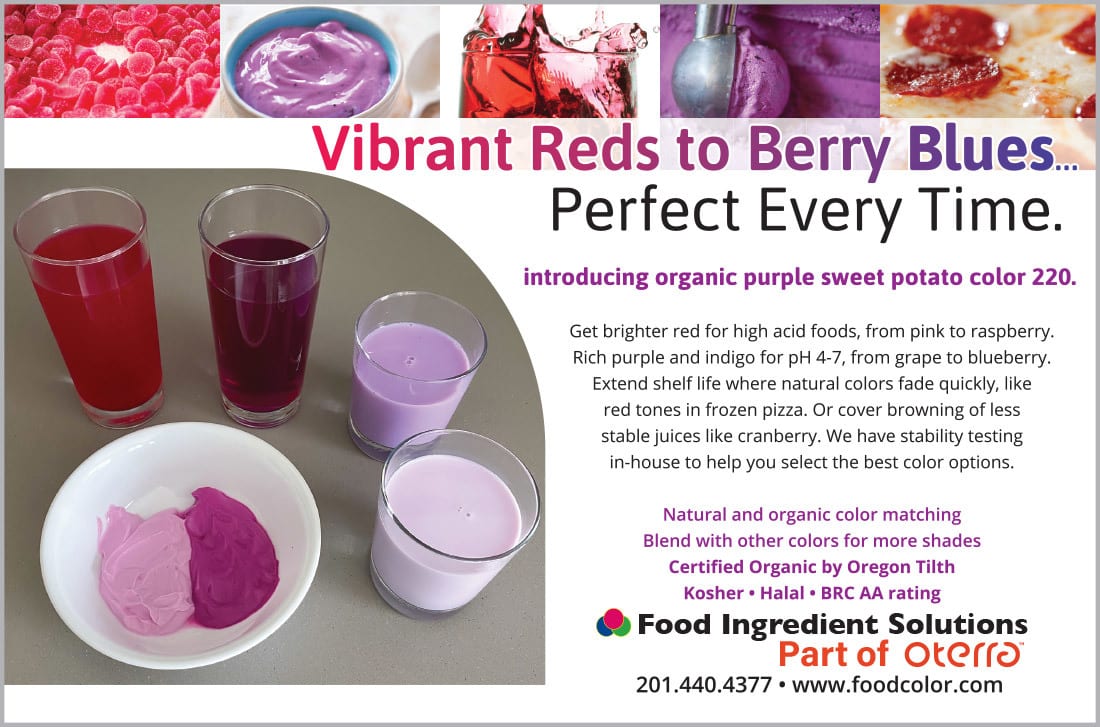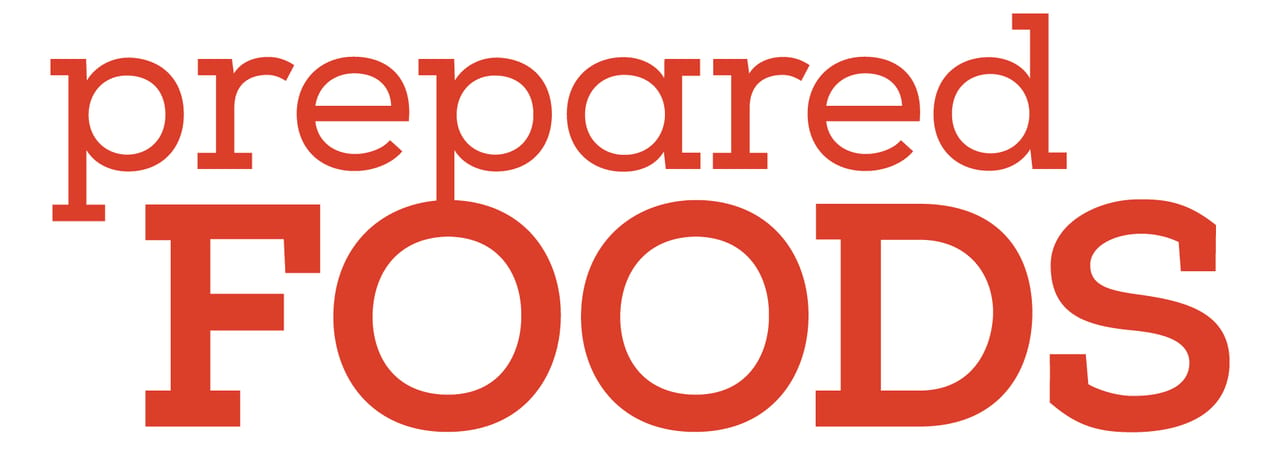July 2022
Future for Snacks
Bright
Bright, natural colors for snacks attract and deliver on novelty, nostalgia, and clean-label.
In 2021, approximately 83% of new snack launches contained natural color. Tellingly, this use of natural colors in a category leaning heavily toward eye-catching indulgence indicates how seriously consumers are now taking clean labels. In 2022 and beyond, food brands and product developers will need to create sweet and salty snacks with vibrant colors and cleaner ingredient lines. Anticipating this, color scientists have greatly expanded not only the offerings but the performance of a rainbow of food coloring options for snacks.
When it comes to formulating sweet and salty snacks, a huge challenge is that of matching the vibrancy, versatility, and stability of synthetic food colorants. “The sensitivity of natural compounds to various stressors within the system causes them to be difficult to depend on and use effectively,” explains Ryan Erwin, food chemist and Innovation Manager for Fresca Foods, Inc. “Because they are organic compounds, natural colors are highly susceptible to heat, light, and pH, all of which denature the coloring compounds, sometimes irreversibly, and chemically change the way they reflect visible light.”
By OLIVIA CONRAD, Contributing Food Science Editor
Today, the use of natural colors in snacks significantly outpaces the use of synthetic food colorants. Photo courtesy of: Getty Images / baibaz

Natural caramel-derived colors can have an added advantage of enhancing flavor notes in a sweet or savory snack. Photo courtesy of: Sethness-Roquette Co.
Certain natural colors can also require much higher usage rates than synthetic counterparts. This can affect formulation ratios and lead to potential color interactions with other ingredients. As developers work to match shades and intensity of synthetic counterparts in snacks, mixing more than one natural pigment may be an option, but may also increase cost, plus it still leaves the label less than “clean.”
Developers shifting to natural colors for established snack formulations can benefit from consulting with a reputable supplier to select the optimal natural color system. These can be trickier, as the system must be customized for a specific food matrix.

Emerging natural colors are providing more stable shades with greater variety to give developers new formulation options. Photo courtesy of: Kalsec, Inc.
New Looks
In recent years, color scientists have made landmark improvements in food colors across two main parameters. They’ve developed a greater range of subtle shades and tones within each color category, and have vastly improved the ability of natural colorants to “fix” in order to avoid bleeding and fading.
Developers may use these new natural colors in the same formats as before, powdered, liquid, or oil preparations. Still, the medium of a color dictates important processing factors, such as order of addition. With snacks typically being low-moisture products, a pre-mixing step that fully hydrates or dissolves the coloring ingredient is vital, especially when it comes to powdered colors.
Fade to White
Prior to the onset of the overarching health and wellness trend that influences the food industry today, synthetic food colorants were commonly used to give bright, vibrant shades to sweet and salty snacks. Synthetic food colors, such as azo dye compounds, are less label-friendly, but typically more cost-effective and chemically stable under a full range of food matrices, processing methods, and storage conditions. The common primary shades in the synthetic color toolkit include Red 40, Blue 1, Yellow 5 Lake, and Yellow 6 Lake, among others. These synthetic colorants may be combined to produce a full spectrum of stable shades. Until recently, titanium dioxide (TiO2) was the most common artificial bright white shade. But, following an EU ban in 2021, that colorant since has been increasingly avoided by US food makers. Colorant makers were able to fill the gap with bright white shades derived from rice starch or cornstarch.
The low moisture content of snacks can also provide some advantages in food-color formulation. The drier the food matrix, the more it provides greater stability of certain pigments that might otherwise be unstable in aqueous environments. For example, anthocyanins (commonly derived from mulberries and purple vegetables, such as carrots and cabbage), which give pink, red, and purple hues, are most stable at a low pH range. Because of this, they will likely have better stability overall in a snack food matrix such as chips or crackers.
Product development scientist for Simply Good Foods Co. and natural colorant expert Olivia Conrad presents key trends in coloring snacks.
Snackstats
According to a 2021 report by Research and Markets, Ltd., published by GlobeNewswire, Inc., the global market for snack foods is around $500 billion and projected to reach nearly three-quarters of a trillion dollars by 2026, based on a CAGR of 6.7%. The US market for snacks alone approached $165 billion last year. Global bakery snack sales are projected to surpass $300 billion by the end of the period, and growth in the salted snacks segment will see a 7.7% CAGR during that time span. This high demand for snack foods globally is said to be driven by “hectic schedules and busy lifestyles” leading consumers to “supplant traditional meal occasions with convenient and healthy snack options.” Coupled to this are “changing dietary habits and rapid urbanization in the developing countries.” The report also cited “increasing disposable incomes along with introduction of innovative products” as influencers.

The Bold and the Beautiful
Today’s consumers are looking for bold and unique colors, especially when used in both innovative and nostalgic ways. For example, in salty snacks, bright red and orange hues can cue intense spice level for the new trend of extra hot and spicy chips, coated nuts, or snack mixes. In the sweet snacks categories, the classic rainbow shades that communicate “birthday cake” flavor, or the familiar pink, white, and brown combination that signifies “Neapolitan ice cream” flavors, are experiencing immense popularity.
Novel shades such as purple, periwinkle blue, and various hues of green also are getting their moment in the limelight. They are proving especially attractive to consumers today when used in the sweet snack and confection categories.
With sustainable, natural ingredients a primary consumer demand, extracts from fruits and vegetables are now a leading sources of food colors. Photo courtesy of: GNT Group BV
What We Crave
In a 2021 report, Research and Markets, Ltd. noted, “Increasing health consciousness, along with a craving for snack foods, is anticipated to result in dynamic demand for low-fat, no-fat, low-sugar, no-sugar, low-carb, no-carb, and low-calorie snack foods.” The report further projected that “the gradually receding line between meals and snacks is churning out additional opportunities for snacking,” and that “future growth in the market will be driven by robust demand for functional snacks, including bars, chips, cookies and yogurt, and surging popularity of protein-fortified, organic, and natural snacks.”
Seasonal launches and collaborations and other such limited-time snack offerings present another opportunity for brands and developers to deliver on fun snack colors and concepts. In any color, a bright hue communicates high flavor impact. Colors in inclusions and additions, such as flavored chips, edible glitter, and unique sprinkle colors, also can help to elevate snack offerings to new levels.
While many consumers today are seeking novel and unique snacks, 74% of consumers today report wanting their food and drink products to be “100% natural.” Further, around 66% of consumers are more conscious of ingredient lines. To deliver on consumer expectations and dietary needs, color manufacturers and ingredient companies are working to bring natural colors with certified claims to market.

Brilliant whites from rice or cornstarch, periwinkles from butterfly pea flowers, and vibrant reds from tomatoes or sweet potatoes are examples of new natural colors. Photo courtesy of: Food Ingredient Solutions, Inc.
“Manufacturers and developers must become familiar with natural, non-GMO, vegan food color alternatives,” says Allie Brimlow, a director for Fresca Foods. “With the rising trend of clean-label ingredients, more and more consumers are looking to the ingredient lines and will be wary of anything they don’t understand, such as Red Dye 40, but won’t mind something they recognize, such as beet powder.”
To deliver on the clean-label and diet-friendly trends, colors manufacturers and ingredient companies are always exploring new natural pigment sources and production methods to create natural colors that are gluten-free, non-GMO, vegan, “plant-based,” and “made with real fruits and vegetables.”
At the same time, color stability and functionality are essential, as this allows consumers to experience the vibrancy and novelty that they expect in snack foods. Looking ahead, as innovation in color manufacturing techniques continues, the industry can expect to see more natural food color lines that are chemically stable and cost-effective, delivering hues that rival the common synthetics. PF
Regular contributor Olivia Conrad is a product development scientist for Simply Good Foods Co. and freelance food science writer in Boulder, Colorado. With a degree in Food Science from the University of Maine, she has extensive experience in natural foods product development for categories ranging from frozen desserts to snacks. She also is an expert in food safety, with a strong working knowledge of FSMA and HACCP. Contact her at oconrad2013@gmail.com or through Prepared Foods.
July 2022


